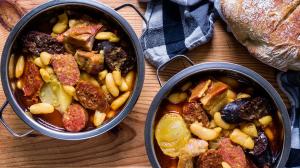. . . of the northern Spanish bean & cured meats stew, as prepared by “PEPA” (a.k.a. Angel’s mama) who is visiting us in Paris for 10 days to see us and cook, cook, and cook !
Here’s the wikipedia definition : fabada asturiana, often simply known as fabada, is a rich Spanish bean stew, originally from and most commonly found in the principality of Asturias, but widely available throughout the whole of Spain and in Spanish restaurants worldwide. Canned fabada is sold in most supermarkets across the country. Fabada is a hot and heavy dish and for that reason is most commonly eaten during winter and at the largest meal of the day, lunch. It is usually served as a starter, but may also be the main course of the meal. It is typically served with crusty bread, and with Asturian cider or a red wine. Fabada is made with dried large white beans (fabes de Granja), soaked overnight before use, salted shoulder of pork (lacòn Gallego) and bacon (tocino), black pudding (morcilla), fresh chorizo sausage and often saffron (azafrán). Some recipes also call for longaniza.The Spanish olla podridda and south-western french cassoulet are both similar to fabada asturiana. Boston baked beans also have some similarities in that they use pieces of pork fat and white beans.
Needless to say, the «exquisiteness» of this very simple dish is accomplished by respecting 2 things :
The 1st is the use of high-quality ingredients available in spanish markets. The reason being is that the only spice use here is saffron, with a whole large onion and a whole head of garlic for extra flavorings and that are discarded at the end, with no added olive oil, no salt nor ground pepper and not even a bay leaf or two (I admit I tried to add some in as we were preparing the fabada but I almost got my head bitten off) !
The 2nd is time, time to soak the beans and salted slab of pork shoulder overnight and the 4 hours of simmering the dish at the lowest heat, with absolutely no stirring (to avoid crushing the beans) and only the occasional gentle shaking of the casserole …
To serve, one gently removes the cooked meats from the casserole, presents them in a separate serving plate alongside the bowls of the bean stew and people simply serve themselves. I prefer cutting up the cooked meats in smaller bite-sized pieces and placing them on top of the bean stew in the bowls and even slicing the onions in half and recuperating the garlic still in its casing and spreading it on the bread …
It was perfect, I wouldn’t change a thing, and even if I tried, they would kill me ! LOL … :)
p.s.: all my ingredients we’re brought to me from Spain by Angel’s mother but for those who live in Paris, a great & brand new SPANISH bistrot & wine cellar & delicatessen has opened up on Daumesnil avenue in the 12th called JAMON JAMON (www.jamon-jamon.fr) and they're really nice.







